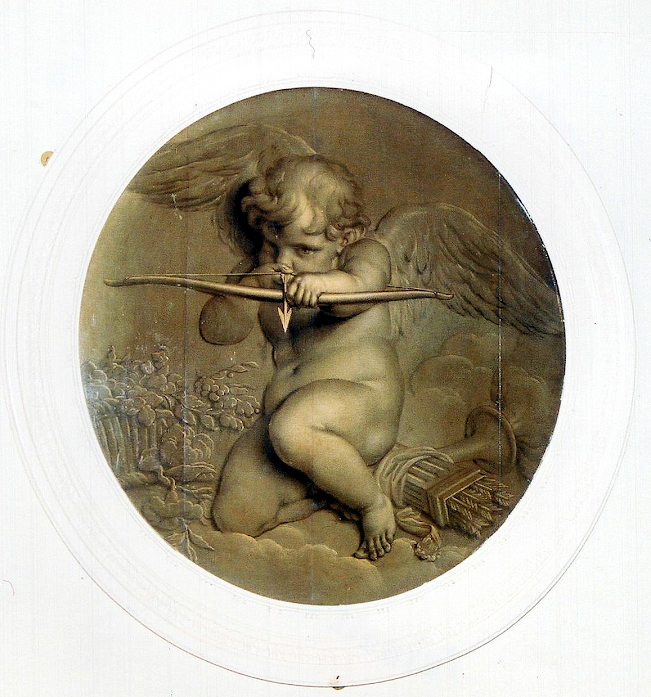CUPID FIRING AN ARROW
ROTONDO OIL PAINTING AT RISK
Photographs
and text © George
W. Randall co-founder in July 1996 and former Vice Chairman Kinloch Castle Friends' Association.
This magnificent painting is part of the Sir
George Bullough, Bt. Memorial
gifted to the British nation by his widow in
February 1957 and located in
Kinloch Castle, Isle of Rum, Scotland. The fully furnished former late
Victorian hunting lodge is today in the care of Scottish Natural Heritage,
an agency funded by and responsible to the Scottish Parliament.
Kinloch Castle, Isle of Rum, Scotland. The fully furnished former late
Victorian hunting lodge is today in the care of Scottish Natural Heritage,
an agency funded by and responsible to the Scottish Parliament.
Regrettably no specific care or funding has ever been allocated for the
preservation / conservation of these magnificent treasures
purchased with tax payers money.
preservation / conservation of these magnificent treasures
purchased with tax payers money.
a technique of
monochrome painting in shades of grey in order to imitate the effect of relief.
18th Century
Continental School. There is no indication of artist or date.
The quiver full
of barbed arrows and still smouldering torch lie on the ground to the
right
in this portrait
of a chubby Cupid. The unattributed and undated painting create
In Roman
mythology Cupid, the son of Venus,
is the god of desire and love. Anyone pierced
with Cupid’s gold-headed arrow is reputedly
filled with an overwhelming
desire to fall in love.
The curvature of
Cupid’s bow symbolises the double curve of the human lip.
Displayed above
the mantel-shelf in one of Kinloch Castle’s period bedrooms in the west wing,
the kneeling Cupid, wings outstretched, his bow drawn,
is about to fire his arrow of love directly at the occupants of the four-poster bed
is about to fire his arrow of love directly at the occupants of the four-poster bed
which faces the
picture.
Professionally
appraised for condition by an art conservator
twenty-eight years ago - March 1996 -
the work was
found to be in “excellent structural condition.”
The painted five
section wood panel consisted of four joints all
“in excellent condition with no
recent movement along the joints.” It was noted the joints had been “previously
filled and retouched but showed no sign of any problem.”
A “slight but
stable concave warp was noted at the top of the central join.”
The “slight
surface spotting and staining” could be improved “by surface cleaning and
re-varnishing”
which, at the time, was considered possible on-site and in-situ without
the need to
remove the work from the wall.
No worm activity
was apparent, but the white circular timber frame was screwed to the wall and the painting
was not removed for examination.
Regrettably the painting is in the same bedroom as Two Putti With Flowers, featured in a previous post, which is riddled with woodworm.
A possible artist is Dutchman Jacob de Wit, (1695-1754),
a member of the Guild of St. Luke or one of his
followers, most notably, Jan de Groot,
Jan Punt, Dionys van Nijmegen or brothers Frans or Jacob Xavery.
Jan Punt, Dionys van Nijmegen or brothers Frans or Jacob Xavery.
If so, this 250 plus year old work is not only extremely
valuable in monetary terms but more so as an unrecognised masterpiece of en-grisaille.
Famous for his religious
scenes, de Wit was particularly noted for
his use of the en-grisaille technique.
As part of my research I found no examples of his en-grisaille work
depicting a cupid firing an arrow,
depicting a cupid firing an arrow,
but many do show groups of boisterous putti or cherubs.
POSTED BY GEORGE W. RANDALL
TO RAISE PUBLIC AWARENESS OF THE LOSS
OF THESE PUBLICLY OWNED ARTIFACTS
SHOULD KINLOCH CASTLE BE DEMOLISHED AND ITS CONTENTS DISPERSED OR DUMPED
NEVER TO BE SEEN AGAIN.
Don't let Britain's heritage slip away
through indifference -
through indifference -
Express your concern by contacting:
THE SCOTTISH PARLIAMENT
St. Andrew's House, Regent Street,
Edinburgh, EH1 3DG, Scotland
Edinburgh, EH1 3DG, Scotland
Telephone: 0141 424 1174
Updated 29 September 2024













No comments:
Post a Comment